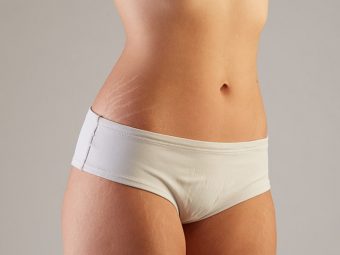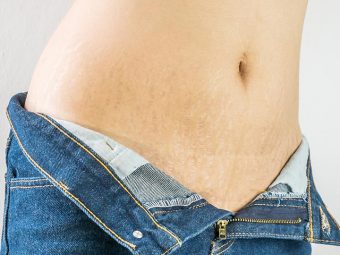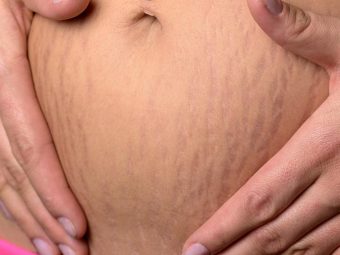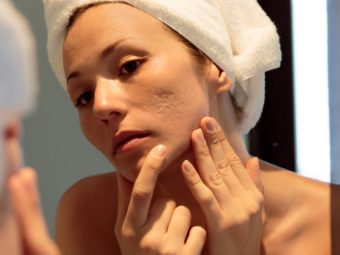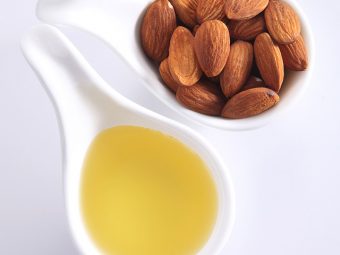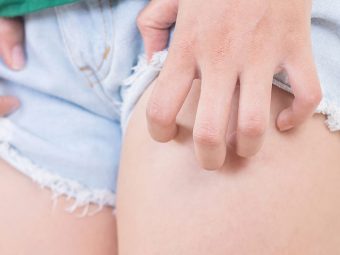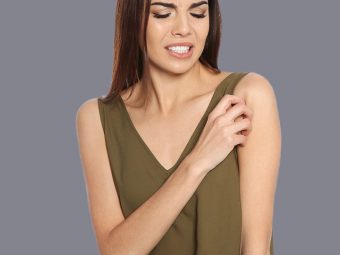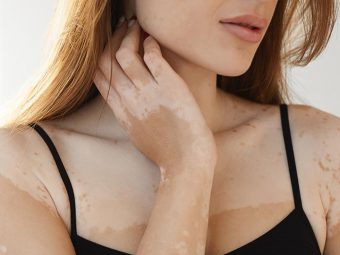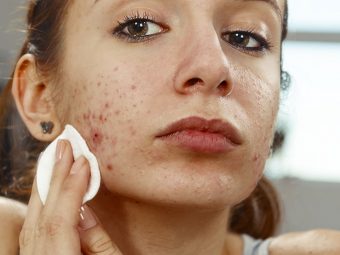Stretch Marks On The Breasts: Causes, Treatment, Prevention, And Risk Factors
Reduce the appearance of these indented streaks with the right line of treatment and care.
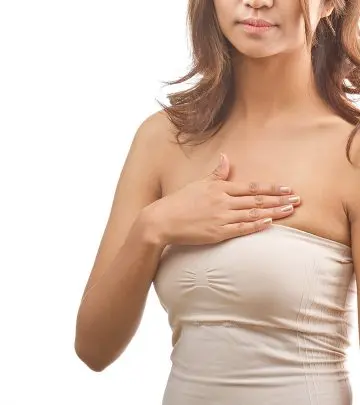
Image: Shutterstock
Stretch marks can only occur on some parts of the body, but something that bothers a majority of women is the stretch marks on breasts. Marks on breasts are a common phenomenon; most women get them. These marks are harmless and may fade away after some time. However, various reasons lead to the formation of stretch marks on breasts.
Stretch marks can fade naturally over time, and home remedies can help prevent them. In this article, we have explained the stretch marks on the breast and all other related issues. Continue reading to know more.
In This Article
Stretch Marks On The Breast: What Do They Look Like?
It is very common for women to develop stretch marks on the breasts. If you examine your breasts closely, you may find long and thin lines or streaks. Those are stretch marks or striae distensae.
Usually, when they first appear, they appear reddish, purplish, or pinkish. These are early stretch marks and are called striae rubra. As the stretch marks get old, you will see the lines turning white. These are old stretch marks and are called striae alba.
Stretch marks are referred to as striae gravidarum if you get them during pregnancy. During pregnancy, apart from your abdomen, you may also develop stretch marks on your breasts, thighs, hips, and buttocks (1).
Several factors are responsible for the development of stretch marks on the breasts and other body parts.
What Causes Stretch Marks On The Breasts?
The factors that might cause the development stretch marks include:
1. Puberty
Adolescents experience hormonal changes in their bodies once they hit puberty. The changes in the hormones also trigger physical changes. During puberty, girls may experience rapid growth in their breast tissue. As the breasts develop, they stretch the skin, which may cause stretch marks on the breasts.
2. Pregnancy
This is the most common cause of the appearance of stretch marks on different body parts, including the breasts. Stretch marks usually start developing by the third trimester. As the baby grows, the rising estrogen levels result in the growth of the milk ducts and the breasts, which may cause stretch marks.
3. Weight Gain Or Loss
A sudden weight gain can also cause stretch marks on the breast. As the breasts contain fat tissues, weight gain can result in an increase in breast size. This stretches the skin and may leave behind marks.
Jessey Anthony, a blogger, shared her experience in a post about her struggle with stretch marks. She says, “After losing 40 pounds, my stretch marks became more of a scar and covered roughly 25% of my entire body…. At this point, my insecurities grew. I definitely wanted to get rid of those annoying stretch marks.My first option was a cosmetic procedure, but it would cost around $2500, which I couldn’t afford despite my desperation at the time. The second option was to try natural home remedies. While some of them worked after using it for about one year and six months, some of them didn’t (i).”
4. Breast Implants And Surgeries
Breast augmentation surgery may also cause stretch marks to develop (2). These surgeries are meant to increase breast size by placing an implant. Placing new implants and repositioning your breasts can stretch the skin, resulting in stretch marks.
5. Breastfeeding
Breastfeeding can cause the breasts to change in size and shape, which may contribute to the development of stretch marks. These marks develop due to the expansion of breast tissue and skin to accommodate the growing mammary glands and milk production. After childbirth, especially if the breasts return to their pre-pregnancy size relatively quickly, the skin may struggle to shrink back, leading to the formation of stretch marks. While breastfeeding does not directly cause stretch marks, the fluctuations in breast size and subsequent changes can be a contributing factor.
6. Muscle Growth
Stretch marks on the breasts can occur during periods of rapid muscle growth or weight gain (3). When the underlying muscles grow, the skin covering them stretches. If the stretching happens too quickly, the collagen and elastin fibers in the skin can tear, leading to the formation of stretch marks.
7. Family History
Your genes can also make you prone to develop stretch marks. If your parents have stretch marks, you may develop them too.
8. Health Conditions
Underlying health conditions may make your skin vulnerable to stretch marks. If you have conditions, such as Marfan Syndrome, Cushing’s Syndrome, and other auto-immune conditions, you may develop stretch marks (4). Often, doctors prescribe corticosteroids for treatment. Using corticosteroids may also increase your risk of developing stretch marks.
Early stretch marks respond well to treatment. This is because they are fresh, and the blood vessels right underneath the skin layer promote collagen development, which makes it easier to improve their appearance. Hence, if you have developed stretch marks, start treatment as early as possible.
 Did You Know?
Did You Know?Treatment And Prevention Options For Stretch Marks On The Breasts
You cannot effectively prevent stretch marks by keeping the skin well moisturized, soft, and elastic at all times. This also will not prevent them from worsening or aid in early healing.
Once the stretch marks have become white/mature, they almost resemble a scar below the skin with very little blood supply and very little repair ability. Clinical treatment methods are needed to improve their appearance once developed. Here are a few ways to both prevent and treat stretch marks on the breast.
Prevention Tips
1. Massage The Stretch Marks
Massaging with moisturizers and emollients helps a lot. Massaging the area helps improve blood circulation and reduce stretch marks. A study found that 15 minutes of massage with bitter almond oil helped prevent pregnancy stretch marks or striae gravidarum (5).
2. Keep Your Skin Hydrated
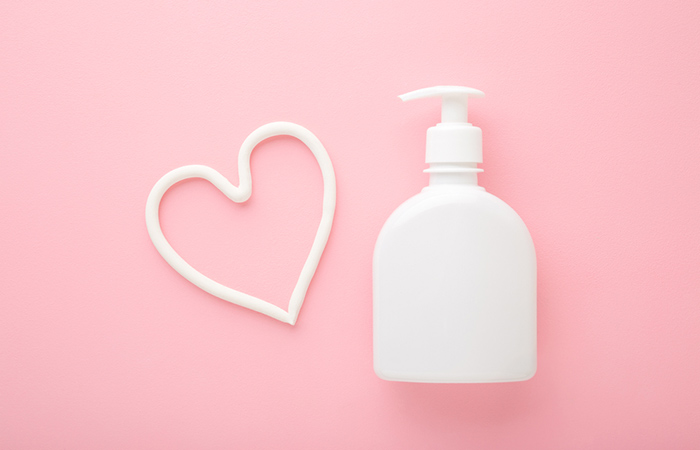
Staying hydrated is another way to prevent stretch marks. In addition to topical moisturization, your skin also needs to stay hydrated from within. Dry skin cannot stretch properly, and this causes the development of stretch marks. Staying hydrated also improves the overall functions of your organs.
3. Exfoliate Regularly
While it is not known if exfoliation can help reduce stretch marks, it can help keep the skin healthy. Regular exfoliation is essential to get rid of the dead skin cells. This also softens the skin and may aid in stretch mark prevention.
You may try the following ingredients to massage and moisturize your skin:
- Bitter almond oil (Note: This is an essential oil, so mix 2-3 drops of this oil with any carrier oil before using it.)
- Almond oil
- Shea butter
- Cocoa butter
- Coconut oil
- Argan oil
- Beeswax
These ingredients work by keeping the skin moisturized and enhancing skin elasticity. This reduces the chances of developing severe stretch marks. Proper moisturization can help reduce stretch marks (6).
If home remedies are not working on the stretch marks, you may have to opt for medical treatment. In such cases, it is best to consult a dermatologist. This is because treatment depends on your skin type and severity of your condition.
 Quick Tip
Quick TipA dermatologist is the best person to decide which type of treatment may work for you and whether you need multiple treatments or not. Usually, the doctor may recommend the following treatment options.
Medical Treatment
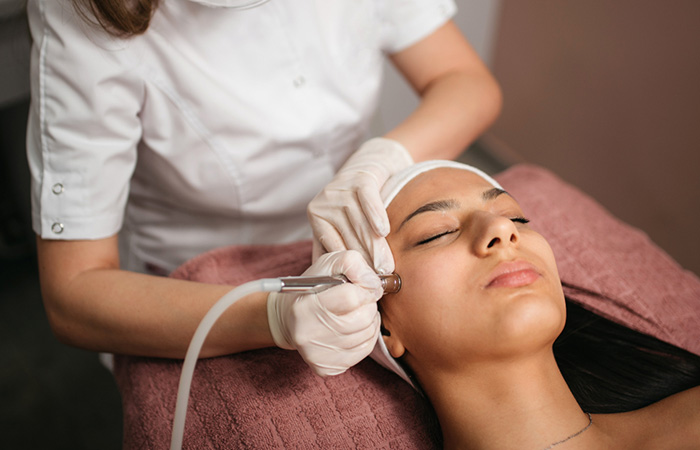
- Laser Therapy: Laser is a safe way to improve the appearance of stretch marks. It helps restore the damaged elastin fibers and improves collagen production (7).
- Acid Peels: These are also one of the popular treatment options for stretch marks (8). Acid peels are used to exfoliate the top layer of your skin to make it smooth.
- Microdermabrasion: This process works well with a combination of other topical treatments like topical tretinoin and PRP (platelet-rich plasma)(9).It is less invasive and requires minimal downtime compared to dermabrasion.
- Collagen Injections: This is a popular treatment option for improving the appearance of scars, stretch marks, wrinkles, and fine lines. This cosmetic procedure is done by injecting collagen right under your skin.
- Radiofrequency: This technique also uses heat energy to stimulate collagen production to treat stretch marks and is found to be quite effective (10).
- Topical Ointments: The doctor may also prescribe topical ointments containing emollients and acids, such as collagen-based creams or gels, creams containing hyaluronic acid, ascorbic acid, glycolic acid, and retinoic acid, etc.
- Surgical Treatment: Breast stretch marks caused due to weight gain issues may require cosmetic surgery to correct their appearance. Surgical procedures like breast reduction or lifting help to give better shape and firmness while minimizing the appearance of stretch marks.
While prevention methods and proper medical treatment are crucial, you also need to stay healthy. Follow a well-balanced diet, exercise, and take care of your skin.
Infographic: Stretch Marks On Breasts – Causes + Treatment And Prevention Tips
Stretch marks develop when your skin shrinks or expands rapidly. Several factors can contribute to the development of these marks on your breasts. Their appearance might be shocking due to their colors, namely purple, red, or pink, but they cause no pain. Fret not, for there are ways to prevent their appearance or at least to reduce them. Check out the infographic below to know more about the causes and preventive tips and treatments for stretch marks on breasts.

Illustration: StyleCraze Design Team
Women commonly develop stretch marks on the breasts due to puberty, pregnancy, medications, genetics, or medical conditions. One can opt for medical treatments such as laser therapy, collagen injections, or acid peels to exfoliate the upper layer of the skin and boost collagen production. If you are looking for natural remedies, you can try exfoliating using natural ingredients such as coconut or almond oil to reduce the risk of developing stretch marks. Other than this, drinking plenty of water and massaging the affected area with moisturizer reduces the appearance of stretch marks on your breasts.
Frequently Asked Questions
Can not wearing a bra cause stretch marks?
Not wearing a bra for a long period of time may cause stretch marks as the breast tissues may stretch and become saggy without proper support.
How common are stretch marks on breasts?
Stretch marks on breasts are extremely common as it is a normal physiological response to stretching of the skin.
How do you hide stretch marks on breasts?
You can use makeup or self-tanner to hide stretch marks on breasts. Wearing clothes with more coverage can also help hide stretch marks.
Key Takeaways
- There are different types of stretch marks, varying in size and color, that can appear on your breasts.
- Stretch marks are caused by puberty, pregnancy, excessive weight loss or gain, surgeries, family history, and some health conditions.
- You cannot prevent stretch marks, but you can stop them from becoming more prominent.
- There are prevention tips and medical treatments you can try to diminish stretch marks.
Women commonly develop stretch marks on the breasts due to puberty, pregnancy, medications, genetics, or medical conditions. One can opt for medical treatments such as laser treatment, collagen injections, or acid peels to exfoliate the upper layer of the skin and boost collagen production. If you are looking for natural remedies, you can try exfoliating using natural ingredients such as coconut or almond oil to reduce the risk of developing stretch marks. Other than this, drinking plenty of water and massaging the affected area with moisturizer reduces the appearance of stretch marks on your breasts.
Say goodbye to those pesky lines on your body with expert-backed tips. Check out this video to discover proven treatments and effective strategies to diminish the appearance of stretch marks and reveal smoother skin.
Personal Experience: Source
StyleCraze's articles are interwoven with authentic personal narratives that provide depth and resonance to our content. Below are the sources of the personal accounts referenced in this article.
i. 8 Beauty Arsenals Every New Mom Needs & I Wish I’d Known Earlierhttps://medium.com/i-mother/8-beauty-arsenals-every-new-mom-needs-i-wish-id-known-earlier-4f02fca6d63b
References
Articles on StyleCraze are backed by verified information from peer-reviewed and academic research papers, reputed organizations, research institutions, and medical associations to ensure accuracy and relevance. Read our editorial policy to learn more.
- Osman, Hibah, et al. “Risk factors for the development of striae gravidarum.” American journal of obstetrics and gynecology 196.1 (2007): 62-e1.
https://www.ncbi.nlm.nih.gov/pmc/articles/PMC1913631/ - Basile, Filipe Volpe, Arthur Volpe Basile, and Antonio Roberto Basile. “Striae distensae after breast augmentation.” Aesthetic plastic surgery 36.4 (2012): 894-900.
https://www.ncbi.nlm.nih.gov/pmc/articles/PMC5782435/ - Management of stretch marks (with a focus on striae rubrae)
https://pubmed.ncbi.nlm.nih.gov/22594386-the-effect-of-bitter-almond-oil-and-massaging-on-striae-gravidarum-in-primiparaous-women/ - Singh, Gurcharan, and Lekshmi P. Kumar. “Striae distensae.” Indian Journal of Dermatology, Venereology, and Leprology 71.5 (2005): 370.
https://www.ijdvl.com/article.asp?issn=0378-6323;year=2005;volume=71;issue=5;spage=370;epage=372;aulast=Singh - Timur Taşhan, Sermin, and Ayşe Kafkasli. “The effect of bitter almond oil and massaging on striae gravidarum in primiparaous women.” Journal of clinical nursing 21.11‐12 (2012): 1570-1576.
https://pubmed.ncbi.nlm.nih.gov/22594386-the-effect-of-bitter-almond-oil-and-massaging-on-striae-gravidarum-in-primiparaous-women/ - Rawlings, A. V., S. Bielfeldt, and K. J. Lombard. “A review of the effects of moisturizers on the appearance of scars and striae.” International journal of cosmetic science 34.6 (2012): 519-524.
https://pubmed.ncbi.nlm.nih.gov/22994859-a-review-of-the-effects-of-moisturizers-on-the-appearance-of-scars-and-striae/ - Wollina, Uwe, and Alberto Goldman. “Management of stretch marks (with a focus on striae rubrae).” Journal of cutaneous and aesthetic surgery 10.3 (2017): 124.
https://www.ncbi.nlm.nih.gov/pmc/articles/PMC5782435/ - Ud‐Din, S., D. McGeorge, and A. Bayat. “Topical management of striae distensae (stretch marks): prevention and therapy of striae rubrae and albae.” Journal of the European academy of dermatology and venereology 30.2 (2016): 211-222.
https://www.ncbi.nlm.nih.gov/pmc/articles/PMC5057295/ - Ibrahim, Zeinab Abd El‐Samad, et al. “Comparison between the efficacy and safety of platelet‐rich plasma vs. microdermabrasion in the treatment of striae distensae: clinical and histopathological study.” Journal of cosmetic dermatology 14.4 (2015): 336-346.
https://pubmed.ncbi.nlm.nih.gov/26147455-comparison-between-the-efficacy-and-safety-of-platelet-rich-plasma-vs-microdermabrasion-in-the-treatment-of-striae-distensae-clinical-and-histopathological-study/ - SUH, DONG‐HYE, et al. “Radiofrequency and 585‐nm pulsed dye laser treatment of striae distensae: a report of 37 Asian patients.” Dermatologic surgery 33.1 (2007): 29-34.
https://pubmed.ncbi.nlm.nih.gov/17214676-radiofrequency-and-585-nm-pulsed-dye-laser-treatment-of-striae-distensae-a-report-of-37-asian-patients/ - Prophylaxis of Striae gravidarum with a topical formulation. A double blind trial
https://sci-hub.se/https://pubmed.ncbi.nlm.nih.gov/19291041/











